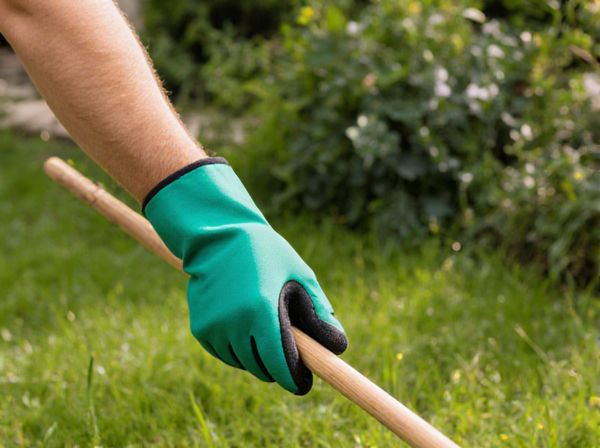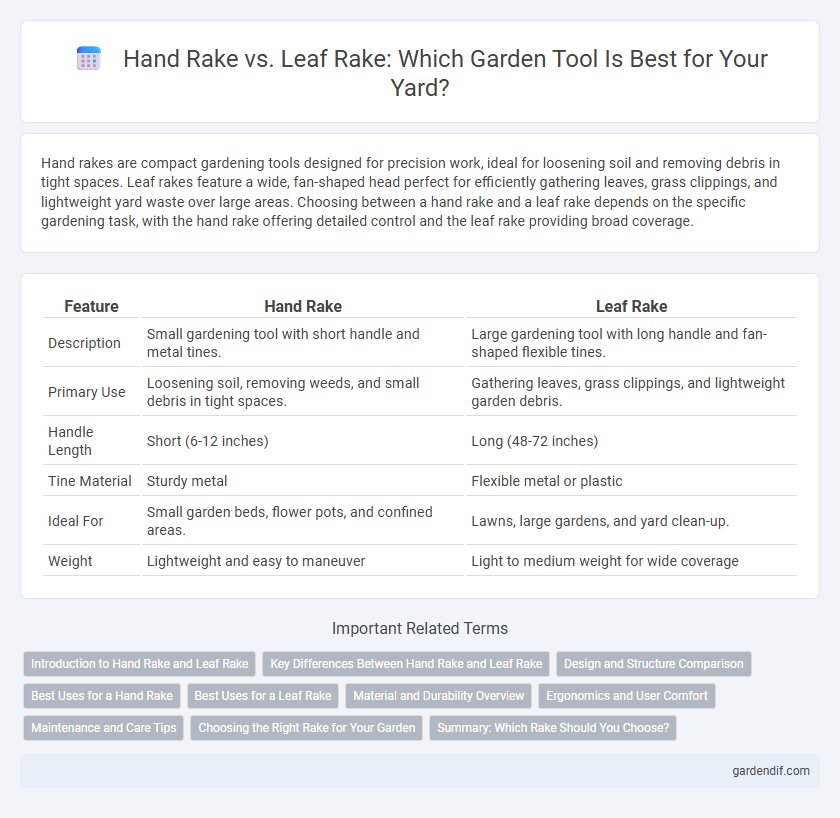
Hand Rake vs Leaf Rake Illustration
Hand rakes are compact gardening tools designed for precision work, ideal for loosening soil and removing debris in tight spaces. Leaf rakes feature a wide, fan-shaped head perfect for efficiently gathering leaves, grass clippings, and lightweight yard waste over large areas. Choosing between a hand rake and a leaf rake depends on the specific gardening task, with the hand rake offering detailed control and the leaf rake providing broad coverage.
Table of Comparison
| Feature | Hand Rake | Leaf Rake |
|---|---|---|
| Description | Small gardening tool with short handle and metal tines. | Large gardening tool with long handle and fan-shaped flexible tines. |
| Primary Use | Loosening soil, removing weeds, and small debris in tight spaces. | Gathering leaves, grass clippings, and lightweight garden debris. |
| Handle Length | Short (6-12 inches) | Long (48-72 inches) |
| Tine Material | Sturdy metal | Flexible metal or plastic |
| Ideal For | Small garden beds, flower pots, and confined areas. | Lawns, large gardens, and yard clean-up. |
| Weight | Lightweight and easy to maneuver | Light to medium weight for wide coverage |
Introduction to Hand Rake and Leaf Rake
Hand rakes feature short, sturdy tines designed for heavy-duty tasks like loosening soil, removing debris, and leveling ground in confined spaces. Leaf rakes have long, flexible tines that efficiently gather leaves and light garden debris over large areas without damaging grass. Choosing between a hand rake and a leaf rake depends on the specific gardening task and the type of material being handled.
Key Differences Between Hand Rake and Leaf Rake
Hand rakes feature short, sturdy tines designed for heavy-duty tasks like breaking up soil and collecting debris in tight spaces, while leaf rakes have long, flexible tines optimized for gathering lightweight leaves and grass clippings over larger areas. The hand rake's compact size offers precise control for garden beds, contrasting with the leaf rake's wide, fan-shaped head that covers broad surfaces efficiently. Choosing between these tools depends on the specific gardening task, soil type, and the nature of the debris to be managed.
Design and Structure Comparison
A hand rake features short, sturdy tines on a compact frame designed for close-up garden tasks like soil aeration and removing weeds. In contrast, a leaf rake has long, flexible tines spread wide on a lightweight, fan-shaped frame to efficiently gather leaves and debris over large areas. The structural differences optimize the hand rake for precision and durability, while the leaf rake excels in coverage and ease of use on lawns.
Best Uses for a Hand Rake
Hand rakes excel at breaking up compacted soil, removing weeds, and preparing garden beds with precision. Their sturdy, short tines provide enhanced control for working around delicate plants and in tight spaces. Unlike leaf rakes designed for gathering lightweight debris, hand rakes are ideal for detailed soil cultivation and targeted garden maintenance tasks.
Best Uses for a Leaf Rake
A leaf rake is best suited for gathering lightweight debris such as grass clippings, leaves, and small twigs from lawns and garden beds. Its wide, flexible tines efficiently collect large surface areas without damaging delicate plants or soil. Ideal for maintaining clean, manicured landscapes, a leaf rake excels in seasonal yard cleanup and light garden maintenance.
Material and Durability Overview
Hand rakes typically feature sturdy steel tines and hardwood or plastic handles, providing excellent durability for heavy-duty tasks like breaking up soil and removing debris. Leaf rakes usually have flexible aluminum or plastic tines with lightweight wooden or fiberglass handles, designed for gentle raking of leaves and grass without damaging delicate surfaces. The material composition directly influences their durability, with hand rakes built to withstand tougher conditions and leaf rakes optimized for flexibility and ease of handling.
Ergonomics and User Comfort
Hand rakes typically feature shorter handles and lightweight tines, providing enhanced control and reducing wrist strain during prolonged use, ideal for precision tasks. Leaf rakes, with their longer handles and flexible, fan-shaped tines, minimize bending and back fatigue by allowing users to maintain an upright posture while covering larger areas efficiently. Ergonomic designs in both tools often include cushioned grips and adjustable handles to improve user comfort and prevent repetitive strain injuries.
Maintenance and Care Tips
Hand rakes require regular cleaning after use to prevent rust and maintain sharp tines, while leaf rakes benefit from occasional straightening of their flexible tines and cleaning of debris to ensure effective performance. Both tools should be stored in a dry place to avoid moisture damage, and handles should be inspected frequently for cracks or splinters, applying oil or varnish as needed to preserve the wood or metal finish. Proper maintenance extends tool lifespan and enhances efficiency during gardening or landscaping tasks.
Choosing the Right Rake for Your Garden
Hand rakes offer precise control for detailed garden tasks like loosening soil or removing debris from flower beds, making them ideal for small areas and delicate plants. Leaf rakes feature wide, fan-shaped heads designed to efficiently gather loose leaves and grass clippings across large lawns. Selecting the right rake depends on the size of your garden and the specific gardening task, ensuring both effectiveness and ease of use.
Summary: Which Rake Should You Choose?
A hand rake offers precision for garden beds and smaller areas, ideal for loosening soil and removing weeds, while a leaf rake covers larger surfaces efficiently, suited for gathering leaves and lightweight debris. Choose a hand rake for detailed garden maintenance and a leaf rake for yard clean-up involving grass clippings and fallen leaves. Selecting the right rake depends on the task size and the material being collected.
Hand Rake vs Leaf Rake Infographic

 gardendif.com
gardendif.com